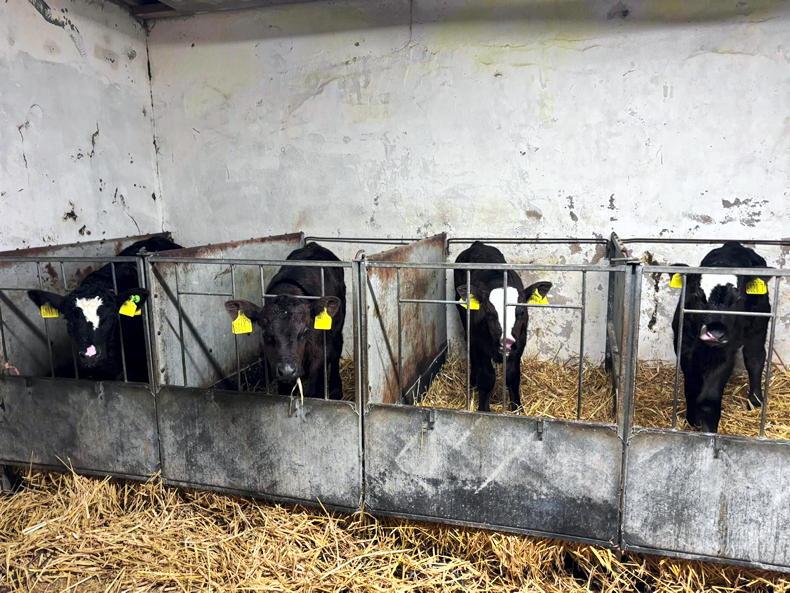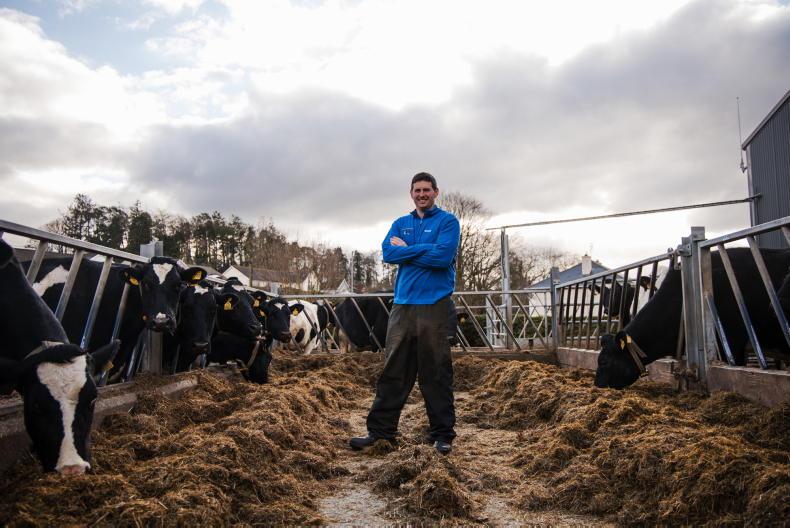In general, most farms are in an ok position at the minute. Those on heavy soils or above the line from Limerick to Dublin are seeing higher than normal growth for the time of the year, with soil temperatures 2-3°c above normal.
Although it’s hard to believe, some paddocks at the higher end of the wedge could be growing over 150kg DM/ha, so careful management and frequent measuring are required.
Those in the traditionally ‘drier’ counties in the south and southeast have seen growth rates drop, although even saying that is a very general statement, with some farms still growing well in excess of demand.
For fear of sounding like a broken record, you can’t manage what you can’t measure, so for each cohort of farmers, whether growth is good, bad or middling, you need to get out twice a week and put a figure on it to properly make decisions to lessen the impact of the weather.
If you are finding yourself in a deficit, the obvious first choice for many will be to up the ration rate in the parlour. Average farm cover needs to be held at 500-550kg DM/ha at a minimum, or 150 kg DM/lu.
Lowering your covers below this will mean grazing covers below 1,000kg DM/ha, where cows will not only mow through these rapidly and further deplete the farm cover and growth rate, but also will likely be in an energy deficit as they won’t be able to get enough of the short grass in to themselves.
If possible, lower the demand further by moving non milking stock, such as calves or heifers, off the platform.
Measure, and measure again. Those in high growth rates need to measure to control grass, while those with low growth need to make sure farm cover isn’t depleted.If growth is extremely strong, continue mowing out paddocks as surplus silage.If growth is poor and there is stem creeping in, pre-mowing is an option.Offload non-milking stock from the grazing block to lower demand.Donal Patton – Teagasc Ballyhaise, Co Cavan
We’re taking out surplus all the time to try control grass. We are still targeting pre grazing yields of 1,300-1,400kg DM/ha. Quality is good, but we are targeting any stemmy covers for mowing out as opposed to topping.
While cover per livestock unit is low, our growth is extremely high so we aren’t concerned about it.
Our clover swards are receiving no chemical N, but have received some dairy washings post grazing. Our red clover silage will be cut a second time in the next few days, as while it’s not overly heavy it is starting to stem out.
Three weeks of breeding are now complete, with a 93% submission rate.
Stocking Rate (cows/ha) 3.83
Growth Rate (kg/day) 130
Average Farm Cover (kg/cow) 145
Yield (l/cow) 22
Fat % 4.4
Protein% 3.43
Milk Solids (kg/cow) 1.85
Concentrates 1.5
TJ Ryan – Rossmore, Co Tipperary
Things are good on the grass side, with the weather suiting the ground well. It’s been hard to keep grass under control, with a lot of baling completed to control growth and quality.
Some of our paddocks are growing over 100kg DM/ha per day, and we are getting back to grazing them within 10-12 days.
At the minute we are grazing 1,300kg DM/ha covers with some stem in them, but after this week quality will be much improved.
Twelve acres were reseeded on Saturday last, with Abergain, Aberchoice, and Aston Energy sown, along with 1kg of Coolfinn white clover. First cut silage will be completed next week.
Stocking Rate (cows/ha) 4.37
Growth Rate (kg/day) 70
Average Farm Cover (kg/cow) 141
Yield (l/cow) 28
Fat % 4.11
Protein% 3.42
Milk Solids (kg/cow) 2.17
Concentrates 3
Brian Ronayne – Dungourney, Co Cork
We measured grass on Monday and decided to act on the dipping growth rate.
We are currently zero grazing 18 acres of silage ground away from home that has a cover of 3,300KG DM/ha on it.
Three loads of grass are going in to cows each day. As we are not able to get cows to eat all the zero grazed grass during milking times, we are holding 20% of the cows in between milkings, with this group of cows rotated.
Concentrates have gone from 3kg to 4kg, meaning the diet now stands at 10kg grazed grass, 4kg concentrates and 3kg of zero grazed grass.
Stocking Rate (cows/ha) 3.33
Growth Rate (kg/day) 52
Average Farm Cover (kg/cow) 144
Yield (l/cow) 22.3
Fat % 4.53
Protein% 3.77
Milk Solids (kg/cow) 1.9
Concentrates 4
In general, most farms are in an ok position at the minute. Those on heavy soils or above the line from Limerick to Dublin are seeing higher than normal growth for the time of the year, with soil temperatures 2-3°c above normal.
Although it’s hard to believe, some paddocks at the higher end of the wedge could be growing over 150kg DM/ha, so careful management and frequent measuring are required.
Those in the traditionally ‘drier’ counties in the south and southeast have seen growth rates drop, although even saying that is a very general statement, with some farms still growing well in excess of demand.
For fear of sounding like a broken record, you can’t manage what you can’t measure, so for each cohort of farmers, whether growth is good, bad or middling, you need to get out twice a week and put a figure on it to properly make decisions to lessen the impact of the weather.
If you are finding yourself in a deficit, the obvious first choice for many will be to up the ration rate in the parlour. Average farm cover needs to be held at 500-550kg DM/ha at a minimum, or 150 kg DM/lu.
Lowering your covers below this will mean grazing covers below 1,000kg DM/ha, where cows will not only mow through these rapidly and further deplete the farm cover and growth rate, but also will likely be in an energy deficit as they won’t be able to get enough of the short grass in to themselves.
If possible, lower the demand further by moving non milking stock, such as calves or heifers, off the platform.
Measure, and measure again. Those in high growth rates need to measure to control grass, while those with low growth need to make sure farm cover isn’t depleted.If growth is extremely strong, continue mowing out paddocks as surplus silage.If growth is poor and there is stem creeping in, pre-mowing is an option.Offload non-milking stock from the grazing block to lower demand.Donal Patton – Teagasc Ballyhaise, Co Cavan
We’re taking out surplus all the time to try control grass. We are still targeting pre grazing yields of 1,300-1,400kg DM/ha. Quality is good, but we are targeting any stemmy covers for mowing out as opposed to topping.
While cover per livestock unit is low, our growth is extremely high so we aren’t concerned about it.
Our clover swards are receiving no chemical N, but have received some dairy washings post grazing. Our red clover silage will be cut a second time in the next few days, as while it’s not overly heavy it is starting to stem out.
Three weeks of breeding are now complete, with a 93% submission rate.
Stocking Rate (cows/ha) 3.83
Growth Rate (kg/day) 130
Average Farm Cover (kg/cow) 145
Yield (l/cow) 22
Fat % 4.4
Protein% 3.43
Milk Solids (kg/cow) 1.85
Concentrates 1.5
TJ Ryan – Rossmore, Co Tipperary
Things are good on the grass side, with the weather suiting the ground well. It’s been hard to keep grass under control, with a lot of baling completed to control growth and quality.
Some of our paddocks are growing over 100kg DM/ha per day, and we are getting back to grazing them within 10-12 days.
At the minute we are grazing 1,300kg DM/ha covers with some stem in them, but after this week quality will be much improved.
Twelve acres were reseeded on Saturday last, with Abergain, Aberchoice, and Aston Energy sown, along with 1kg of Coolfinn white clover. First cut silage will be completed next week.
Stocking Rate (cows/ha) 4.37
Growth Rate (kg/day) 70
Average Farm Cover (kg/cow) 141
Yield (l/cow) 28
Fat % 4.11
Protein% 3.42
Milk Solids (kg/cow) 2.17
Concentrates 3
Brian Ronayne – Dungourney, Co Cork
We measured grass on Monday and decided to act on the dipping growth rate.
We are currently zero grazing 18 acres of silage ground away from home that has a cover of 3,300KG DM/ha on it.
Three loads of grass are going in to cows each day. As we are not able to get cows to eat all the zero grazed grass during milking times, we are holding 20% of the cows in between milkings, with this group of cows rotated.
Concentrates have gone from 3kg to 4kg, meaning the diet now stands at 10kg grazed grass, 4kg concentrates and 3kg of zero grazed grass.
Stocking Rate (cows/ha) 3.33
Growth Rate (kg/day) 52
Average Farm Cover (kg/cow) 144
Yield (l/cow) 22.3
Fat % 4.53
Protein% 3.77
Milk Solids (kg/cow) 1.9
Concentrates 4










SHARING OPTIONS